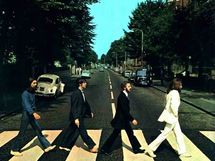
McCartney alone walked in bare feet, out of step with his bandmates, a cigarette in his right hand -- unusual for a leftie, perhaps, but enough to feed a generation's worth of "Paul is dead" rumours.
Re-enacting the walk across Abbey Road is what hundreds of tourists -- walking single file, eyes firmly looking straight ahead -- come to the well-heeled Saint John's Wood neighbourhood do every day.
"It's one of the rare unchanged places in Beatles history, somewhere that we can get an idea of what it was like at the time," a Beatles fan from California said the other day.
"The challenge is to exactly re-create the picture," said Christopher, who was visiting from France with his friend Thierry and spent an hour on Abbey Road with their four teenaged children.
"Except that you need a step ladder and to set yourself up in the middle of the street," Thierry explained.
It might be hard to match the fashions of the day.
Lennon, who would be shot and killed in New York in December 1980, was in head-to-toe white. Behind him was Ringo in black, then barefoot Paul. George brought up the rear in blue denim shirt and bell-bottoms.
"It's crazy to say that we've walked at the exact same place as they did," said Lucille, 15.
"And so near to the anniversary," added her brother Paul. "But we told ourselves it would be better to come a few days early, because there are going to be too many people on Saturday."
Because it is a zebra crossing, with orange beacons atop striped poles flashing at either end, motorists must stop for all pedestrians -- Beatles pilgrims or otherwise.
But there are drivers who "honk their horns and shout not very nice things in English" when tourists dawdle too long in the middle of the two-lane street that is, in fact, part of a busy intersection, said Paul.
The nearby Abbey Road studios -- the world's first purpose-built recording facility when it was opened in the early 1930s -- merits a visit as well.
The Beatles made nearly all their records there, and in its history it has hosted a raft of other artists -- names as diverse as Fred Astaire and Fats Waller to U2, Oasis and Manic Street Preachers.
Propped atop its roof is a webcam (www.abbeyroad.co.uk/visit) that peers down on the crosswalk -- making virtual visits to Abbey Road possible from anywhere on Earth.
----------------------------------------------------------------------------------------------------------------------
Re-enacting the walk across Abbey Road is what hundreds of tourists -- walking single file, eyes firmly looking straight ahead -- come to the well-heeled Saint John's Wood neighbourhood do every day.
"It's one of the rare unchanged places in Beatles history, somewhere that we can get an idea of what it was like at the time," a Beatles fan from California said the other day.
"The challenge is to exactly re-create the picture," said Christopher, who was visiting from France with his friend Thierry and spent an hour on Abbey Road with their four teenaged children.
"Except that you need a step ladder and to set yourself up in the middle of the street," Thierry explained.
It might be hard to match the fashions of the day.
Lennon, who would be shot and killed in New York in December 1980, was in head-to-toe white. Behind him was Ringo in black, then barefoot Paul. George brought up the rear in blue denim shirt and bell-bottoms.
"It's crazy to say that we've walked at the exact same place as they did," said Lucille, 15.
"And so near to the anniversary," added her brother Paul. "But we told ourselves it would be better to come a few days early, because there are going to be too many people on Saturday."
Because it is a zebra crossing, with orange beacons atop striped poles flashing at either end, motorists must stop for all pedestrians -- Beatles pilgrims or otherwise.
But there are drivers who "honk their horns and shout not very nice things in English" when tourists dawdle too long in the middle of the two-lane street that is, in fact, part of a busy intersection, said Paul.
The nearby Abbey Road studios -- the world's first purpose-built recording facility when it was opened in the early 1930s -- merits a visit as well.
The Beatles made nearly all their records there, and in its history it has hosted a raft of other artists -- names as diverse as Fred Astaire and Fats Waller to U2, Oasis and Manic Street Preachers.
Propped atop its roof is a webcam (www.abbeyroad.co.uk/visit) that peers down on the crosswalk -- making virtual visits to Abbey Road possible from anywhere on Earth.
----------------------------------------------------------------------------------------------------------------------









 Home
Home Politics
Politics









